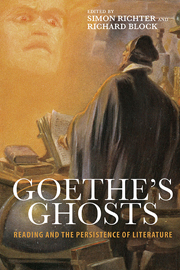Book contents
- Frontmatter
- Contents
- Introduction—Ghosts and the Machine: Reading with Jane Brown
- Part I The Ghosts of Goethe's Past
- Part II The Ghost That Keeps on Giving
- Part III Spirited Encounters
- 11 The Imagination of Freedom: Goethe and Hegel as Contemporaries
- 12 Effacement vs. Exposure of the Poetic Act: Philosophy and Literature as Producers of “History” (Hegel vs. Goethe)
- 13 Toward an Environmental Aesthetics: Depicting Nature in the Age of Goethe
- 14 “Ein heimlich Ding”: The Self as Object in Annette von Droste-Hülshoff
- 15 “Ja, Goethe über alles und immer!”: Benn's “Double Life” in His Letters to F. W. Oelze (1932–56)
- Bibliography of Jane K. Brown's Publications
- Notes on the Contributors
- Index
13 - Toward an Environmental Aesthetics: Depicting Nature in the Age of Goethe
from Part III - Spirited Encounters
Published online by Cambridge University Press: 05 March 2014
- Frontmatter
- Contents
- Introduction—Ghosts and the Machine: Reading with Jane Brown
- Part I The Ghosts of Goethe's Past
- Part II The Ghost That Keeps on Giving
- Part III Spirited Encounters
- 11 The Imagination of Freedom: Goethe and Hegel as Contemporaries
- 12 Effacement vs. Exposure of the Poetic Act: Philosophy and Literature as Producers of “History” (Hegel vs. Goethe)
- 13 Toward an Environmental Aesthetics: Depicting Nature in the Age of Goethe
- 14 “Ein heimlich Ding”: The Self as Object in Annette von Droste-Hülshoff
- 15 “Ja, Goethe über alles und immer!”: Benn's “Double Life” in His Letters to F. W. Oelze (1932–56)
- Bibliography of Jane K. Brown's Publications
- Notes on the Contributors
- Index
Summary
On 16 March 1807 Johann Wolfgang von Goethe received from the publisher his long-awaited copy of Alexander von Humboldt's groundbreaking work on comparative plant geography, Ideen zu einer Geographie der Pflanzen nebst einem Naturgemälde der Tropenländer (Essay about the geography of plants accompanied by a table depicting the tropical regions), which he reportedly finished reading eagerly. Unfortunately and by accident, the copy sent to Goethe did not include the plate with the table visualizing the geography of tropical plants announced in the title of the book. In a later letter, Goethe recalls how he read the work with great interest and tried to compensate his disappointment about the missing image by drawing his own version. He eventually published this image in 1813 in the journal Allgemeine Geographische Ephemeriden. I begin my essay on depicting nature in the Age of Goethe with this anecdote because it highlights the central importance of the illustration that condenses the results of the scientific discussion into one image. Images are composed according to certain aesthetic principles. On a series of examples drawn from the archive of European expedition narratives and their illustrations, I reconstruct the history of scientific illustrations in the eighteenth and early nineteenth centuries that leads to the development of an environmental aesthetics, that is, a mode of depicting plants and animals within an environment that is deliberately staged to display ecological insights.
- Type
- Chapter
- Information
- Goethe's GhostsReading and the Persistence of Literature, pp. 262 - 275Publisher: Boydell & BrewerPrint publication year: 2013



